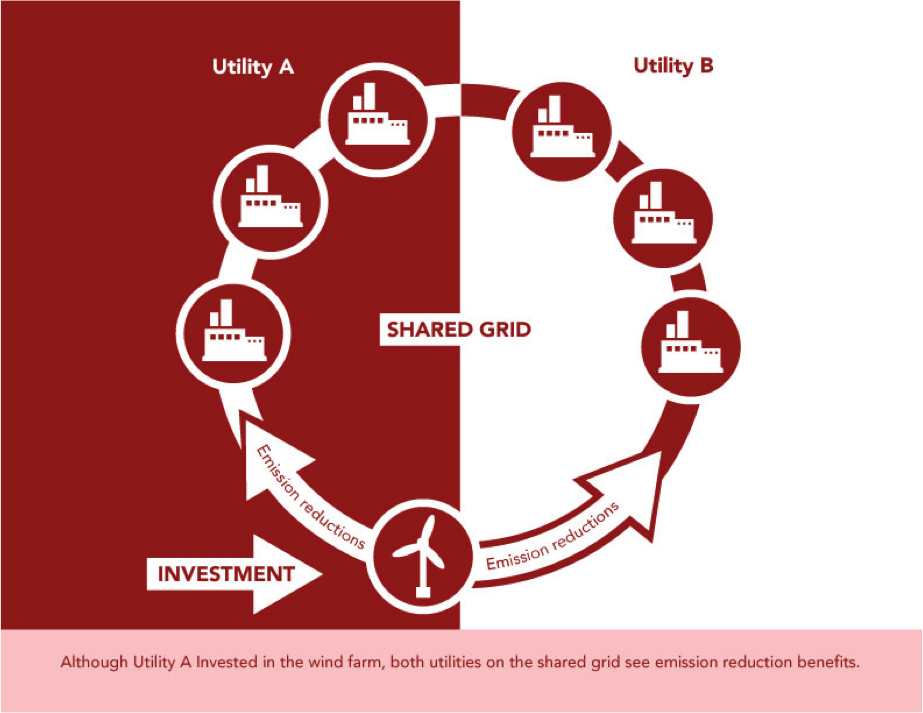
Allocation based on historical generation is likely to result in a "tragedy of the commons," because the cost of measures (such as developing a wind farm) are borne by the investing utility, but the emissions reduction benefits accrue to all that use the grid (including other utilities and power generators).
The Supreme Court has put a temporary hold on enforcement of the Clean Power Plan while lawyers battle over its ultimate fate, but here at AEE we’re confident the rule will prevail — and we’re keeping busy in the meantime, working with the long list of states committed to planning for compliance. We’ve got plenty of advice for states, and today we’re focusing on those that would choose to comply using mass-based plans. Bottom line: How you distribute the emission allowances needed for compliance makes a difference.
Under mass-based compliance for the Clean Power Plan (CPP), states meet their EPA standard by staying within an emissions budget set in terms of tons of carbon. How to manage that budget poses a series of other questions:
- Will a fair and competitive market for emission reduction measures develop to identify lowest-cost solutions?
- Will energy efficiency and distributed energy resources be deployed to provide cost savings for ratepayers?
- Will utilities and power generators that are first movers on compliance be rewarded, or disadvantaged?
- Will states be locked into 2015 solutions for compliance in 2030, or will innovation be rewarded and new solutions be allowed to compete?
The answer to all of these questions rests on how a state chooses to allocate allowances under a mass-based system. More specifically, the best outcomes, for utilities and ratepayers, depend on whether all eligible measures are able to compete equally to provide emission reductions at lowest cost. There are a number of approaches for states to consider that could, if designed appropriately, deliver on that basis.
Advanced Energy Economy Institute (AEE Institute) has developed one such solution and detailed it in a new paper, A Performance-Based Approach to Allowance Allocation for Clean Power Plan Compliance.
Performance-based allocation is based on a simple principle: allow all eligible technologies to participate and compete on the basis of performance and cost. While this goal may seem easy enough to achieve, many allocation schemes would actually impede equal participation and reinforce existing market barriers that often prevent deployment of beyond-the-fence measures.
Existing mass-based trading systems for regulating carbon emissions, in the U.S. and in Europe, have used a variety of allocation approaches—and had a variety of outcomes. The Regional Greenhouse Gas Initiative (RGGI) in the northeast has lowered carbon emissions while delivering ratepayer savings by allocating allowances via auction and reinvesting the proceeds in energy efficiency programs, renewable energy, and ratepayer rebates. In contrast, the European Union’s emission trading system (EU ETS) was costly for consumers in early years due to its reliance on an upfront allocation to affected entities based on historical generation, which overcompensated power generators at the expense of ratepayers. The EU’s allocation system has addressed the issue by shifting away from this allocation system and toward greater reliance on allowance auctions.
Allocation to existing electricity generating units on the basis of historical generation is also the proposed approach under EPA’s proposed mass-based Federal Plan and Model Trading Rule. For states that choose to adopt it, the historical generation approach will limit compliance options, hamper competition, and introduce significant market uncertainty, which is likely to ultimately drive higher compliance costs for electricity customers.
Fortunately, states—even those subject to a Federal Plan—have numerous preferable alternatives. AEE Institute outlines one of them: performance-based allocation.
Under performance-based allocation, allowances would be distributed to renewable energy generators, energy efficiency providers, and others based on actual megawatt-hours (MWh) of reduced-emission generation or energy savings from the previous year, adjusted to reflect the emission reductions achieved. Just as under a rate-based system, zero-emitting measures would get full “credit” for each MWh of generation or savings, while low-emitting resources (including existing power plants operating below their technology-specific EPA performance rate) would receive credit on a pro-rated basis according to their emission profile.
Power plants and utilities subject to CPP jurisdiction would be able to turn to these providers of cost-effective beyond-the-fenceline measures to purchase allowances for compliance purposes, which would create a market opportunity for advanced energy providers. It would also offer assurance to utilities and other market participants that any investments they make in measures such as energy efficiency will bring them the compliance benefits they need.
The performance-based allocation system described in the paper also provides for the Clean Energy Incentive Program, provides controls for the risk of leakage to new power plants not regulated by CPP (as required of state plans by EPA), and still leaves states with several choices for how to distribute the remaining allowances, which will constitute a significant portion of each state’s total emissions budget. These options include auction, allocation to load-serving entities, and updating output-based allocation, which would allocate allowances to affected units and other generators based on their output, rather than historical performance. Auctions have many advantages, such as overall efficiency and transparency, but the paper notes that this is an area where individual state goals and needs will be important considerations.
By establishing a straightforward platform that allows all measures to compete on a technology-neutral basis, performance-based allocation will lower costs for consumers, provide market certainty for utilities and advanced energy providers alike, and allow cost and performance to determine the deployment of different emission reduction measures. In other words, this approach will ensure that states achieve optimal outcomes across a wide range of benchmarks—cost, electricity system performance, innovation, consumer savings—while also meeting their CPP compliance targets. States that decide to go mass-based in their compliance strategy should give it serious consideration.
